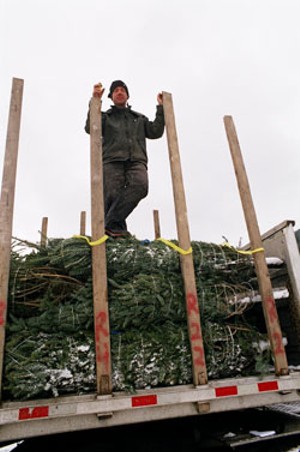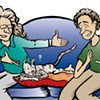Published December 3, 2008 at 6:57 a.m.
If the Friday after Thanksgiving gets painted “black,” the following day is definitely “green.” Last Saturday morning, it seemed like every other car driving west on Route 15 had a balsam on board — anecdotal evidence of the state’s $12 million Christmas tree industry. Despite the fake-tree trend, and new competition from Wal-Mart and Home Depot, it appears plenty of Vermonters are still sold on the benefits of farm-fresh fir.
But the trees were going south, not west, from Moffatt’s Tree Farm on Wild Branch Road in Craftsbury. Owner Steve Moffatt and his crew spent all afternoon loading an 18-wheeler with 600 Christmas conifers destined for the wealthy New York suburbs. The procedure was complicated by the fact that it was a “split load,” meaning the trees were going to two different places. Half were headed to the First Congregational Church in Chappaqua, New York — Hillary Clinton country. The other half were bound for Pound Ridge, where the median household income is $168,040.
“It’s a different market from North Wolcott,” Moffatt yelled down from atop the growing pile of pine in the back of the truck. Assisted by a cherry picker, two young male workers on the ground and his 71-year-old dad, Jim, the 40-year-old jokingly — and unnecessarily — apologized for the “industrial” scene. The vast acreage surrounding it, which include fields of snow-dusted conifers and faraway forest, was classic Currier & Ives Christmas.
Enterprising Vermonters have been working the trade routes to Boston and New York City since the state became a republic. Whether they’re buying milk, meat or trees, city dwellers are willing to pay top dollar for Green Mountain products. Plus, “No Vermonter ever bought a Christmas tree until the 1970s,” Jim Moffatt, the voice of history, recalled. “They’d go out in the woods — theirs or someone else’s — and just cut one.”
Steve’s grandfather had a dairy farm when he started running “wild trees” to Hartford and Springfield in the 1930s. But when Jim took over from his dad, he sold the cows and shifted the farm’s focus to wood products; the land — composed of 750 mostly forested acres — naturally lends itself to logging.
Come November, though, the Moffatt chainsaws are interested in one thing: shapely conifers that range in height from three to 15 feet. A crew of nine fells the Fraser fir first, because that variety of Christmas tree holds its needles the longest. The popular balsam and prickly blue spruce typically aren’t cut until the middle of November.
Steve has also introduced a frost-evading West Virginian Canaan fir to the plantation. A University of Vermont grad with a degree in plant and soil science, he’s got his father beat on “book learning,” as the elder Moffatt called it, and he stands out in local tree-growing circles for being young, articulate and eco-sensitive. But the way he says “hard” — with a flat “a” that makes it sound like “had” — gives him away for what he is: a third-generation Vermont farmer.
Over the decades, the Moffatts have built up a wholesale operation that is large for a family-run Christmas tree farm. Jim takes charge of the on-site, choose-and-cut business, while Steve sells and ships in excess of 5000 trees to retailers every year. More than half of them go to fundraising groups that are selling Christmas trees for charities, including Burlington’s City Market, which donates the proceeds to COTS.
Those clients tend to be more “consistent year to year,” Steve explained. “In bad times, people still tend to support ’em, and that’s good for us.” Despite charging more for his trees this year, he says he lost only one customer. “The vast majority took expensive trees, and more of them,” he reported. Will the Tannenbaum, like the Thanksgiving turkey, turn out to be recession-proof?
The sun was going down fast, and Moffatt’s tower of tightly packed pines had reached the legal limit of 13.5 feet, when he jumped down off the load to weigh in.
SEVEN DAYS: I guess there’s an art to loading a truck with trees.
STEVE Moffatt: I do like the truck to look nice — not only for pure aesthetics, but if the Department of Transportation sees it, and the sideboards are way wide, and there are trees hanging off, they don’t like to see that. Also . . . there is a lot of potential for damage when you’re loading. Some people can walk across a load of trees and you don’t hear any branches cracking. Other people just can’t do it. I’m mainly thinking about that: minimal damage, good-looking load and maximum number of trees. I’m always trying to squeeze ’em in.
SD: How many tractor-trailers do you dispatch in the course of a season?
SM: Seven. I have two left . . . Most wholesale growers of my size want their trees shipped out by Thanksgiving. I prefer not to cut them that early.
SD: And you’ll cut until . . .
SM: I have cut as late as December 23. If someone calls me up and wants some trees, I’ll try to get ’em. I want to cut all I can, and sell all I can, especially when it’s a premium grade. Only a low percentage of trees make the premium grade.
SD: What makes it a premium tree?
SM: Basically, good all the way around. You generally don’t have one particularly weak side, no obvious major defects, no big holes. Generally what most consumers would consider a perfect tree, whatever that means.
SD: How many trees do you have growing here?
SM: If you said 100,000, that wouldn’t be inaccurate. It’s about 1000 trees to an acre.
SD: How long does it take to grow a Christmas tree?
SM: I’d say, in my case, 10 to 12 years.
SD: Are there ways to speed that up?
SM: Oh, yeah. Fertilizer, lots of herbicide and pesticide usage.
SD: But you’re not doing that stuff?
SM: I’m not doing that stuff as aggressively; I don’t want to. I’ve got enough in the ground, I’d just as soon wait a little bit.
SD: It must take a lot of planning to make sure you have the right number for years go come.
SM: I really have been pretty fortunate over the last 10 years. My dad’s brother had a plantation up in Newark, and we used to buy trees from him. As that phased out, I bought a pretty big plantation in Barton. This guy had planted the Christmas trees, and he raised them up to about 5 feet. He liked to do it but he didn’t have any market for ’em . . . I cut ’em and I had the market. I finished that plantation off last year. I knew I was going to be short, so I leased a big plantation of trees in Walden. That came along just at the right time.
SD: Your workers have nicknames for the plantations, don’t they?
SM: Oh, yeah. Hell Hole. Moose Turd Circle. Doe Valley. Bed Spring Flat. Worst Turd Knob. Lot of turd references.
SD: Is it an easy business to get into?
SM: You’d have to buy the land, buy the trees, get ’em started, wait — say, if you had really good luck — six years for a return. Then, even if you have the trees, if you’re going to cut ’em, you definitely have to have a bailer, a tractor, a trailer. It’s a big, long-term investment. I was fortunate because when I got started, a lot of stuff was in place . . . When I took over the business, there were a lot of trees in the ground, you know, coming. I didn’t have to build a customer base — it was pretty much there. I have expanded it significantly.
SD: What varieties are you growing here?
SM: I have the native balsam. I also have Fraser fir and Canaan fir, which is native to West Virginia. It’s a variety of balsam fir. It would be like a MacIntosh versus a Honeycrisp.
SD: Why did you introduce that?
SM: Because they start growing much later in the spring. This is kind of a high-elevation valley, and I tend to get late-spring frosts. If you get those with Christmas trees, it will kill the new growth. It just looks terrible. I started planting those because they generally don’t start growing until the first week of June, when the frost danger is generally past. And a side benefit of that is, the majority of pests which bother the native balsam attack the new growth in the spring. These Canaans are so late, they avoid a lot of those insect problems.
SD: So you’re outsmarting the insects?
SM: I have so far. I’ve been doing it for about 10 years, so we’ll see if they catch on. My guess is they will.
SD: I notice you’ve also got some Scotch Pine, a.k.a. “Crotch Pine”?
SM: Very few. They were very popular in the ’70s . . . The big players are balsam, Fraser and Canaan. I sell my Canaan as balsam. I think they smell as good.
SD: What’s your favorite variety?
SM: There’s a reason the Fraser are expensive: They only grow under very specific conditions. It has to be perfectly well-drained soil or they’ll just die. What they like to do is get up to about 6 feet tall, a year before you’re going to harvest, and then they like to die. That’s their favorite habit. But I guess I’d have to say I prefer the balsam. If you get a good Fraser, it’s great, but boy, they can be awfully miserable, to get ’em to go.
SD: Did you study the science of growing Christmas trees at UVM?
SM: I ended up being a plant and soil science major. I think I was grasping at something familiar, so I took a lot of forestry and plant stuff that I enjoyed. It was almost a self-designed major.
SD: Has it made you a better Christmas tree farmer?
SM: Oh, definitely. I try to be very scientific about growing them on different sites. But oftentimes all the education, all the input, all the money you spend, sometimes it just boils down to being in the right place — I’ve seen it time and time again. You can almost do no wrong at the perfect site. And at the wrong site, you can do no right. I do soil tests, and the results come back and some of my highest production areas, you know, by the book, by the soil test, they test the worst. And some of my poorest production areas test the best.
SD: Any consumer trends you’ve noticed?
SM: Overall, houses are getting bigger. There is a trend for bigger trees.
SD: Despite the economy?
SM: Ultimately, I think people are going to cough up the extra money for a top-grade tree. I think it’s recession-proof to some degree. Right now, everybody out there in the tree business, myself included, has got what my dad always referred to as the “preseason jitters” . . . But I truly believe most people out there are going to buy a tree. You might buy one less present, but you’re probably going to have a tree. Until Santa’s done, we don’t know how this is going to turn out.
SD: Especially in the places you’re delivering.
SM: Exactly. I sell trees in Shelburne, too, and they consider anything less than eight feet a “tabletop.”
SD: What are the biggest threats to your operation?
SM: The weather. Spring frosts scare me to death. There’s nothing I can do. Not only that, but the weather in the fall, at harvest time. Last year we had two feet of snow. That makes it very hard.
SD: Do you see any evidence of global warming?
SM: There’s no question that I have seen remarkable changes in the climate. We used to have a big sugaring operation. Our sugar maples are dead and dying. I’d be very surprised, when I’m my father’s age, if there is a live sugar maple on our property. I’m not saying I know the answer, but the trees are dying — not only the old ones, but the young ones.
SD: What about pests?
SM: Our summers are definitely a lot wetter, and we’re starting to see a lot more disease-related issues. The Christmas trees are denser. There’s more foliage than a wild tree. If they are wet for too long, that creates perfect conditions for fungus. I’m seeing more strange stuff coming up. It used to be Fraser was out of our “hardiness” zone, and I have not seen winter damage on the Fraser for a number of years. And we’re cold here.
SD: What kind of tree do you cut for yourself?
SM: Balsam.
SD: When do you put it up?
SM: I don’t know.
SD: You haven’t put it up yet?
SM: Oh, God, no.
SD: Last minute?
SM: Oh, yeah. People always say, “Oh, you must have the best tree.” Sometimes I pick something out of the pile, just random. Usually my wife Sharon and the boys pick it out. But she’s picked out some trees that I wouldn’t really consider top-notch trees.
SD: Ever argue about it?
SM: Never. I don’t really care at that point. But once it’s up, I do enjoy it. After Christmas, I kinda relax. I like to look at it. Sharon’s like, “Get it out.” I am always kind of reluctant to get rid of it.
There was one tree, behind the house, in the upper fields, that I just loved. It was probably one of the nicest trees I’ve ever grown. In fact, I wanted to tie a note on it somewhere, ’cause I have no idea where it will go. I wanted to say, “This is one of the nicest trees I’ve ever seen. Please call me and tell me where you are.” I always thought it would be nice to do that: randomly pick one and put a note on it.
SD: You log other trees here, too, right?
SM: Yeah, for timber. Mature balsam. Hardwood as well.
SD: What percentage of your revenues is from Christmas tree sales?
SM: Over 95 percent.
SD: Is your goal here simply to make a living off the land?
SM: Sure, yeah. I wanna make a living, I want to pay my health insurance. I want to put a little away for retirement. I want to maintain my buildings and my fleet of vehicles. We don’t live really high on the hog . . . My long-term goal is make enough money to keep the farm the way it is. I would hate to think of selling parts of it off to development. We sold development rights to the 250 acres right here to the Vermont Land Trust. It was a good move.
SD: What kind of prices do you get for these trees?
SM: My little cheap tabletops are seven bucks. My high-end, top-of-the line, 13-foot Fraser — gee, I don’t know what I’m charging for those: $45, $50. Pretty reasonable.
SD: You have two young sons. Do you think either of them will want to keep this tree-farm tradition going?
SM: I have no idea. I’m sort of in the same position my dad was with me: If they want to, that would be great. There are definitely easier ways to make a living.
SD: What are the necessary qualities?
SM: A lot of this business is very physical. As far as that goes with me personally, I can definitely take that. I really like to work hard . . . The mental end of it is very important as well. I have to be very organized. Things change very quickly . . . You’re running your own business. That requires a certain touch.
Want a closer look?
Eva Sollberger interviews Jim and Steve Moffatt in this week's "Stuck in Vermont". Click here to watch the video.
More By This Author
Speaking of Agriculture
-

Q&A: Eliot Lothrop Found His Dream Restoration Project in a Richmond Barn
Aug 30, 2023 -

Video: Restoring the East Monitor Barn in Richmond With Eliot Lothrop
Aug 24, 2023 -

Did Your Garden Flood? Here's What to Know
Jul 28, 2023 -

Q&A: Chet and Kate Parsons Talk About Their Final Lambing Season in Richford
Apr 12, 2023 -

Video: Last Lambing Season for Chet and Kate Parsons at the Parsons’ Farm in Richford
Apr 6, 2023 - More »
Comments
Comments are closed.
From 2014-2020, Seven Days allowed readers to comment on all stories posted on our website. While we've appreciated the suggestions and insights, right now Seven Days is prioritizing our core mission — producing high-quality, responsible local journalism — over moderating online debates between readers.
To criticize, correct or praise our reporting, please send us a letter to the editor or send us a tip. We’ll check it out and report the results.
Online comments may return when we have better tech tools for managing them. Thanks for reading.















































